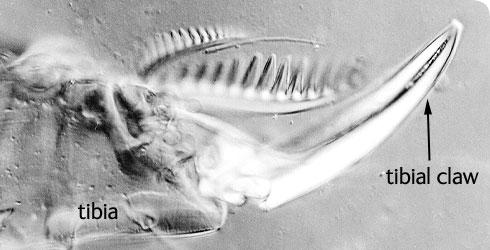Behaviour
Nutrition
Cheyletus eruditus is a free-living predator.
The movable digit of each of the two chelicerae is needle-like and used to pierce the prey’s exoskeleton.
Predatory cheyletids are thought to inject a paralyzing saliva immediately after piercing. The body fluids of the immobilized prey can then be sucked out.
Cheyletus eruditus feeds on a variety of arthropods. Insect prey includes:
- first instar larvae of Cryptolestes ferrugineus (rusty grain beetle)
- first and second instar larvae of Cr. turcicus (flour mill beetle)
- eggs of Ctenocephalides felis (cat flea)
- psocids (booklice; Psocoptera)
- early instar larvae of storage moths
Preferred mites belong to the families Acaridae and Glycyphagidae (order Astigmata). The species Acarus siro and Lepidoglyphus destructor (= Glycyphagus d.) - two of the commonest food storage pests - are particularly attacked.
All active life stages of C. eruditus are cannibalistic in the absence of other prey. Clutches of eggs often include a few that have collapsed, their contents having been eaten by the mother and/or her newborn daughters.
Starvation decreases egg-laying and initiates a nomadic period. (Coombs and Woodroffe, 1968; Solomon, 1969; Summers and Witt, 1972; Berreen, 1976; Hughes, 1976; Zdárková, 1979; Berreen and Metwally, 1984; Yoshikawa, 1987; Williams and Hallas, 1988; Barker, 1991; Gerson et al., 2003; Kucerova, 2004)
Disease
The presence of C. eruditus in infested materials, including domestic items such as straw mats and mattresses, has been blamed for causing dermatitis in humans who touched them.
Cheyletus malaccensis, a species that occurs in similar habitats to C. eruditus, has been shown to feed on human body fluids. This resulted in an allergic reaction and the formation of small itchy bumps. (Hill and Gordon, 1945; Yoshikawa, 1980, 1987; Musken et al., 1996; Colloff, 2009)
